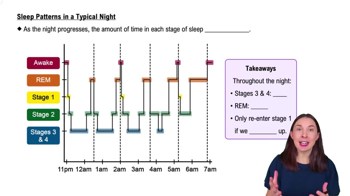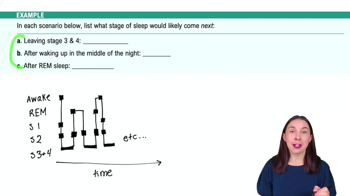Table of contents
- 1. Introduction to Psychology1h 43m
- 2. Psychology Research2h 20m
- 3. Biological Psychology2h 41m
- 4. Sensation and Perception28m
- 5. Consciousness and Sleep32m
- 6. Learning41m
- 7. Memory34m
- 8. Cognition37m
- 9. Emotion and Motivation35m
- 10. Developmental Psychology33m
- 11. Personality48m
- 12. Social Psychology41m
- 13. Stress and Health41m
- 14. Psychological Disorders44m
- 15. Treatment47m
5. Consciousness and Sleep
Sleep
Struggling with Psychology?
Join thousands of students who trust us to help them ace their exams!Watch the first videoMultiple Choice
Mateo is often a victim of bad dreams, frequently centered around being left at a store or getting lost at an amusement park. He sometimes wakes up from them, and calls for his parents to help him calm down. Mateo is experiencing
A
night terrors.
B
nightmares.
C
REM behavior disorder.
D
somnambulism.
 Verified step by step guidance
Verified step by step guidance1
Begin by understanding the key differences between nightmares and night terrors. Nightmares are vivid dreams that can cause feelings of fear, anxiety, or distress, and typically occur during REM sleep. Night terrors, on the other hand, occur during non-REM sleep and often involve intense fear, screaming, or thrashing without full awakening.
Consider the symptoms described in the problem. Mateo experiences bad dreams that he remembers and calls for his parents after waking up, which aligns more closely with nightmares rather than night terrors.
REM behavior disorder involves acting out dreams during REM sleep due to a lack of muscle atonia, which is not described in Mateo's case. Somnambulism, or sleepwalking, involves walking or performing other activities while asleep, which is also not mentioned.
Reflect on the emotional content of Mateo's dreams, such as being left at a store or getting lost, which are typical themes of nightmares that can cause distress upon waking.
Conclude that the correct term for Mateo's experience is nightmares, as they involve waking up and recalling the dream, seeking comfort, and experiencing distress, which matches the description provided.

 3:25m
3:25mWatch next
Master Circadian Rhythms with a bite sized video explanation from Hannah Gordils
Start learningRelated Videos
Related Practice


































































































![Race, Genes and IQ Differences | Bret Weinstein [Mini Clip]](https://img.youtube.com/vi/IztL_m3pd70/mqdefault.jpg)



































































































